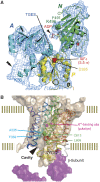Inter-subunit interaction of gastric H+,K+-ATPase prevents reverse reaction of the transport cycle
- PMID: 19387495
- PMCID: PMC2693145
- DOI: 10.1038/emboj.2009.102
Inter-subunit interaction of gastric H+,K+-ATPase prevents reverse reaction of the transport cycle
Abstract
The gastric H(+),K(+)-ATPase is an ATP-driven proton pump responsible for generating a million-fold proton gradient across the gastric membrane. We present the structure of gastric H(+),K(+)-ATPase at 6.5 A resolution as determined by electron crystallography of two-dimensional crystals. The structure shows the catalytic alpha-subunit and the non-catalytic beta-subunit in a pseudo-E(2)P conformation. Different from Na(+),K(+)-ATPase, the N-terminal tail of the beta-subunit is in direct contact with the phosphorylation domain of the alpha-subunit. This interaction may hold the phosphorylation domain in place, thus stabilizing the enzyme conformation and preventing the reverse reaction of the transport cycle. Indeed, truncation of the beta-subunit N-terminus allowed the reverse reaction to occur. These results suggest that the beta-subunit N-terminus prevents the reverse reaction from E(2)P to E(1)P, which is likely to be relevant for the generation of a large H(+) gradient in vivo situation.
Figures



Comment in
-
One way for the gastric proton pump.EMBO J. 2009 Jun 3;28(11):1535-6. doi: 10.1038/emboj.2009.137. EMBO J. 2009. PMID: 19494845 Free PMC article. No abstract available.
References
-
- Abe K, Kaya S, Imagawa T, Taniguchi K (2002) Gastric H/K-ATPase liberates two moles of Pi from one mole of phosphoenzyme formed from a high-affinity ATP binding site and one mole of enzyme-bound ATP at the low-affinity site during cross-talk between catalytic subunits. Biochemistry 41: 2438–2445 - PubMed
-
- Agard DA (1983) A least-squares method for determining structure factors in three-dimensional tilted-view reconstructions. J Mol Biol 167: 849–852 - PubMed
-
- Asano S, Io T, Kimura T, Sakamoto S, Takeguchi N (2001) Alanine-scanning mutagenesis of the sixth transmembrane segment of gastric H+,K+-ATPase α-subunit. J Biol Chem 276: 31265–31273 - PubMed
-
- Asano S, Kimura T, Ueno S, Kawamura M, Takeguchi N (1999) Chimeric domain analysis of the compatibility between H+,K+-ATPase and Na+,K+-ATPase β-subunits for the functional expression of gastric H+,K+-ATPase. J Biol Chem 274: 22257–22265 - PubMed
-
- Asano S, Tega Y, Konishi K, Fujioka M, Takeguchi N (1996) Functional expression of gastric H+,K+-ATPase and site-directed mutagenesis of the putative cation binding site and the catalytic center. J Biol Chem 271: 2740–2745 - PubMed
Publication types
MeSH terms
Substances
LinkOut - more resources
Full Text Sources
Molecular Biology Databases

